79 years ago today, UNESCO was first formed to promote world peace by uniting countries through education, the arts, sciences, and culture. Fostering universal respect for all nations, UNESCO (which stands for United Nations Educational, Scientific and Cultural Organization) has 193 member states sponsoring projects that improve literacy, provide technical training and education, advance science, and preserve regional and cultural history. READ the major milestone UNESCO just completed in Iraq… (1945)
 Machu Picchu in Peru by Pedro Szekely, CC license
Machu Picchu in Peru by Pedro Szekely, CC licenseUNESCO’s largest and most well-known activity is the designation of landmarks that hold cultural or natural importance. These UNESCO World Heritage Sites are masterpieces of human creative genius and landmarks of nature. Designated as ‘patrimony’, with outstanding value to the story of humanity, there have been 1,223 sites protected across 168 countries, so far. Italy is the country with the UNESCO World Heritage Sites (60) with China closely following with 59—and Germany some distance behind at 54. The United States has 26, many of which are natural.
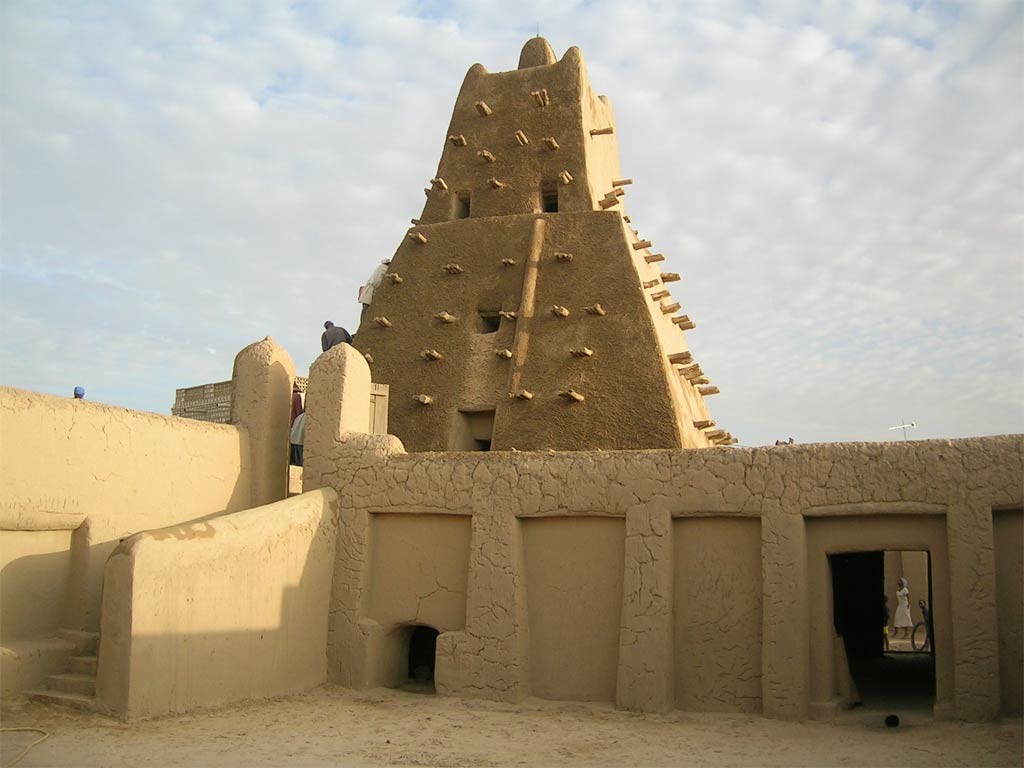 Mali mausoleum – UNESCO / F. Bandarin
Mali mausoleum – UNESCO / F. BandarinUNESCO has also launched global movements, such as Education For All, to further advance its core objectives of ensuring no child goes uneducated. UNESCO also plays a large role in the protection of monuments and patrimony from destruction, but natural and human-caused. At the time of writing, UNESCO’s ‘Reviving the Spirit of Mosul’ Campaign just completed a landmark restoration in the northern Iraqi city that was once the capital of ISIS.
 – credit, UNESCO, released.
– credit, UNESCO, released.The famous al-Nuri ‘Leaning Minaret’ of the 12th-century mosque of the same name was just rebuilt with its signature lean intact. Reviving the Spirit of Mosul has also seen over 120 heritage buildings restored from war damage according to the original plan and design of the age in which they were built, and many of them are now not only inhabited by local families, but some by the very craftsmen whose traditional skills informed their reconstruction. (1945)
MORE Good News on this Date:
67 years ago today, Hall of Famer Bill Russell registered the single-game record for most rebounds with 49 as the Boston Celtics beat the Philidelphia Warriors 111-89 at Boston Gardens. It was Russell’s second season with the Celtics, after starting the previous one in a dynasty featuring 5 future Hall of Famers. Against the Warriors he broke the record for corralling 40 rebounds which had never been done before, but he registered another 9 for good measure.
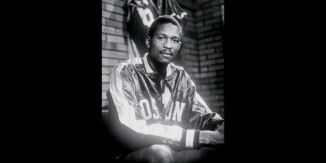 Bill Russell when he signed for the Celtics in 1957
Bill Russell when he signed for the Celtics in 1957Russell averaged 16.6 points per game and a league-record average of 22.7 rebounds per game, creating a sense that there was no player more talismanic to the team in the league, and it won him the MVP award that year. While the Celtics didn’t win the Finals that year, (some say because Russell picked up an injury in game 3) the next season Russell eclipsed these averages and they won the Championship at a canter after setting a record for regular season wins.
The season after that, Russell shattered his own rebound record by putting up 60 in a game against the Syracuse Nationals. To this day, Russell owns 3 of the top 4 personal rebound records in the NBA, while he and Wilt Chamberlain are the only players in NBA history with more than 20,000 career rebounds + the only ones to average more than 20 rebounds per game throughout their respective careers. (1957)
 And 36 years ago, Benazir Bhutto became the first woman to lead a Muslim state when she was elected the Prime Minister of Pakistan in the first open election there in more than a decade. A liberal and secularist, she also led the center-left Pakistan Peoples Party (PPP) to victory in 1993 as a champion of democracy and women’s rights.
And 36 years ago, Benazir Bhutto became the first woman to lead a Muslim state when she was elected the Prime Minister of Pakistan in the first open election there in more than a decade. A liberal and secularist, she also led the center-left Pakistan Peoples Party (PPP) to victory in 1993 as a champion of democracy and women’s rights.
Following United States-brokered negotiations with President Pervez Musharraf, she returned to Pakistan in 2007 to compete in the 2008 elections, emphasizing civilian oversight of the military and opposition to growing Islamist violence, but during a political rally in 2007, she was assassinated by Islamist extremists. She wrote an autobiography, Daughter of Destiny, and before her death authored Reconciliation: Islam, Democracy, and the West. (1988)
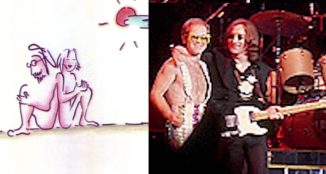
And, 50 years ago today, John Lennon hit No.1 with his catchy single Whatever Gets You Through The Night—his only number 1 solo tune in the U.S. Elton John sang harmony and played piano on the session, and while in the studio, he bet Lennon that the song would top the charts, with its energizing horn section. Such was Lennon’s skepticism that Elton secured from him a promise to appear on stage if the record hit number one. The Beatle, indeed, kept his side of the deal and appeared live with Elton at Madison Square Garden on November 28—and it was Lennon’s last major concert appearance.
According to This Day in Music, they played three songs together: I Saw Her Standing There, Lucy in the Sky With Diamonds and, of course, Whatever Gets You Through the Night. WATCH the original music video featuring John Lennon’s drawings animated by Yoko Ono… (1974)
32 years ago today, the Hoxne Hoard was found in Suffolk. The Hoxne Hoard is the largest collection of late-Roman gold and silver found in Britain, and the largest collection of gold and silver coins of the fourth and fifth centuries found anywhere within the Roman Empire. In 1993, the Treasure Valuation Committee valued the hoard, found by metal detectorist Eric Lawes, at £1.75 million (about £3.79 million in 2021).
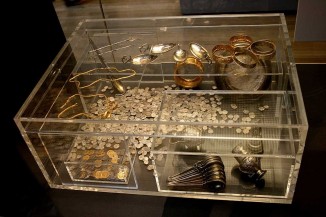 The Hoxne Hoard on display at the London Museum. CC SA 4.0. Mike Peel
The Hoxne Hoard on display at the London Museum. CC SA 4.0. Mike PeelFound in an oak chest, the coins of the hoard date it after CE 407, which coincides with the end of Britain as a Roman province. Cooperation between experienced private metal detectorists and archeologists resulted in the further excavation of the field in Suffolk where the hoard was found, and revealed hundreds of other Roman metal objects, mostly coins, but also box fittings, which are assumed to be part of the chest it was buried in.
A single post hole was found by archeologists, but otherwise, no evidence of a structure of any kind was turned up—the post hole is assumed to have been a marker to remind where the chest was.
569 gold and 14,272 silver coins were found, struck in dies all across the empire, from northern Germany to eastern Turkey. The hoard also contained many pieces of golden jewelry, but which may have represented the “reserve” items rarely or never used from the collection of a wealthy woman or family.
Some of the most common types of jewelry are absent, such as brooches, pendants, and earrings. Items set with gems are notably missing, although they were very much in the taste of the day.
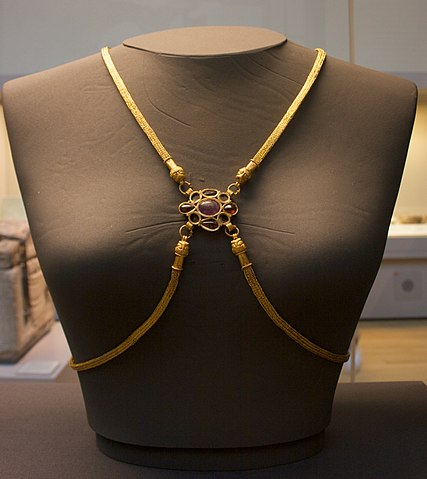 Hoxne Hoard Jewelry – CC SA 4.0. Mike Peel
Hoxne Hoard Jewelry – CC SA 4.0. Mike PeelThe discovery and excavation of the Hoxne Hoard improved the relationship between the archeological profession and the community of metal detectorists which is huge in Britain. Archeologists were pleased that Lawes reported the find promptly and largely undisturbed, allowing a professional excavation.
The Treasure Act 1996 is thought to have contributed to more hoards being made available to archeologists for study. The act changed the law so that the owner of the land and the person who finds the hoard have a strong stake in the value of the discovery. (1992)
SHARE The Milestones, Memories, and Music…
Source link

